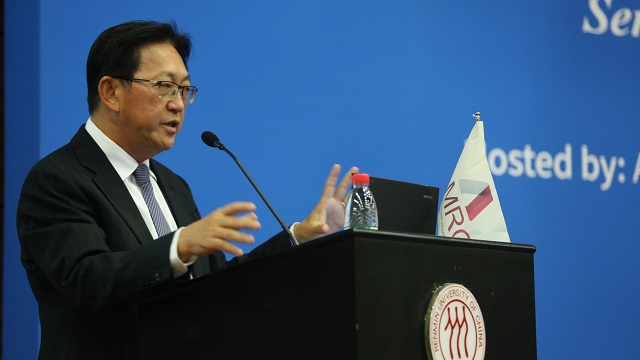
Renowned experts discuss the ASEAN+3 regional economic outlook at a seminar on May 24, 2017 in Beijing, China. From left to right: Mr. Wei Benhua, Former Director of China’s State Administration of Foreign Exchange and First Director of AMRO; Prof. Gao Haihong of the Chinese Academy of Social Sciences, AMRO Chief Economist Dr Hoe Ee Khor, Prof. Tu Yonghong of the International Monetary Institute of RUC; Prof. Lu Feng of Peking University; and Prof. Xiang Songzuo of the International Monetary Institute of RUC.
Beijing, China, May 24, 2017 – The ASEAN+3 region witnessed a brighter regional economic outlook, yet risks remain, according to renowned experts at a seminar on the regional economic outlook 2017 co-organized by the ASEAN+3 Macroeconomic Research Office (AMRO) and the International Monetary Institute of Renmin University of China (RUC) on May 24, 2017, in Beijing, China.
The seminar discussed issues covered in the ASEAN+3 Regional Economic Outlook (AREO) 2017released by AMRO in early May in Yokohama, Japan. As AMRO’s annual regional surveillance publication, the AREO 2017 assesses the regional economic outlook and financial stability in 10 ASEAN countries, and China (including Hong Kong), Japan, and Korea. In this inaugural edition, the report also includes a thematic study of the region 20 years after the Asian Financial Crisis (AFC).
Attended by 60 participants, including academia, analysts, and graduate students of RUC, the seminar was opened by Ms Li Hongxia, Deputy Director General of the Department of International Economic Relations, Ministry of Finance of China. Ms. Li congratulated AMRO on the successful launch of the AREO 2017 as part of AMRO’s effort in contributing to regional macroeconomic and financial stability.
Risks and opportunities
In his presentation on key findings from the AREO 2017, AMRO Chief Economist Dr Hoe Ee Khor said the regional economic outlook has improved with a recovery in global trade and investment. The ASEAN+3 regional growth is projected at 5.2% and 5.1% for 2017 and 2018, respectively, led predominantly by domestic demand. The recent rebound in global capital spending and exports, if sustained, would provide some upsides to growth. Risks are tilted to the downside, from tightening global financial conditions, trade protectionism and global policy uncertainties.
In China, growth in the first half of the year is likely to be higher than in the second half as strengthening industrial production supports growth but SOE reforms and the moderating property markets will be a drag on growth in the second half of the year. For 2018, growth is expected to moderate slightly.
Findings from the thematic study showed that the AFC has shaped policymakers’ perspectives on crisis management and resolution. In the past two decades, policy attention has shifted to capital flows and contagion risks, and the need for a flexible policy framework.

AMRO Chief Economist Dr Hoe Ee Khor delivers a presentations on key findings of the ASEAN+3 Regional Economic Outlook (AREO) 2017 recently released by AMRO.
Maintaining continued openness to global trade and investment
The seminar continued with a lively panel discussion among Dr Khor, Prof. Gao Haihong of the Chinese Academy of Social Sciences, Prof. Lu Feng of Peking University, and Prof. Tu Yonghong and Prof. Xiang Songzuo of the International Monetary Institute of RUC.
In the discussion moderated by Mr. Wei Benhua, Former Director of China’s State Administration of Foreign Exchange and First Director of AMRO, renowned experts generally agreed with AMRO’s assessments on the regional economic outlook, especially on trade and investment. However, one panelist noted that financial integration had lagged behind and this may become a drag on potential growth.
Another panelist highlighted three downside risks to growth in China, including potential risks to financial stability due to speculation in the financial sector; the widening income gap and inequality; and slowing total factor productivity growth.
One panelist supported AMRO’s analysis that spillovers from China’s exchange rate movements on financial markets and exchange rates in the region are becoming more significant, especially with the inclusion of the Renminbi in the SDR basket and the Belt and Road Initiative.
In response to questions from the audience, a panelist noted that the recovery of economies in the region after the AFC was facilitated by the robust U.S. economy at that time which supported the rebound in the region’s exports. The rebalancing from external to domestic demand was the region’s response to the collapse in external demand from the US and Europe after the Global Financial Crisis and the European sovereign debt crisis. However, the region should not swing all the way towards a self-sufficient model of growth, but instead maintaining its continued openness to global trade and investment.
The discussion is the first in a series of roadshows to introduce the AREO 2017 across the region, and will be followed by seminars in Singapore, Jakarta, and Bangkok in the coming weeks.
